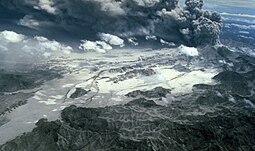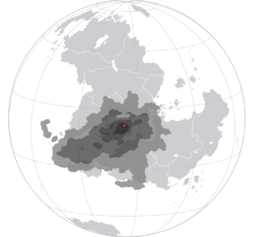2020 eruption of Mount Micchiano: Difference between revisions
m (→Aucuria) |
|||
| Line 55: | Line 55: | ||
==== Imagua and the Assimas ==== | ==== Imagua and the Assimas ==== | ||
The Imaguan economy was severely damaged due to Imagua's close proximity to the Pico de Sangue, as {{wp|agriculture}} was damaged due to sustained ashfall, greatly affecting farms in the northern parts of Imagua and the Assimas, as well as to a lesser extent in the southern parts of the country. It was estimated that the entire harvest in the parishes of [[Saint Isidore's Parish]] and [[Saint Fiacre's Parish]] was "an economic total loss," while most grazing land in the northern plain was also substantially affected by the ashfall. As Imaguan airspace was closed for nearly a month, Imagua's {{wp|tourism}} sector was greatly damaged, which was exacerbated by the requisition of [[Imaguan Maritime Service]] ferries to evacuate foreign nationals from Imagua to [[Eldmark]] or [[Aucuria]]. | |||
This led to a decrease in economic growth in the third quarter by 18%, and this led to a jeopardization of around a third of the country's jobs, as around 30% are imployed in the tourist sector, or in jobs dependent on it, and 2.5% are employed in agriculture. This led to the government of [[Douglas Egnell]] pledging to bail out agricultural and tourist businesses, to ensure that "all will be able to maintain their jobs." | |||
==== Maracao ==== | ==== Maracao ==== | ||
Revision as of 00:33, 31 December 2020
This article is incomplete because it is pending further input from participants, or it is a work-in-progress by one author. Please comment on this article's talk page to share your input, comments and questions. Note: To contribute to this article, you may need to seek help from the author(s) of this page. |
| 2020 eruption of Pico de Sangue | |
|---|---|
 Pyroclastic flow runs down the southern cliff of Pico de Sangue, 16 September 2020 | |
| Start date | September 15, 2020 |
| End date | October 8, 2020 |
| Location | Pico de Sangue, Vasconha Town, Demora Province, Maracao |
| VEI | 6 |
| Impact | large scale loss of life, mass destruction of property, significant economic devastation |
| Deaths | 40,000–80,000 (est.) |
 Map detailing the quantity of ash fallout due to the eruption across Asterias Superior and Inferior | |
The 2020 eruption of Pico de Sangue occurred at the the Pico de Sangue volcano in central Maracao between September 15 and October 8, 2020. The phreatomagmatic eruption measured a 6 on the Volcanic Explosivity Index, the largest in modern Maracan history and one of the largest eruptions recorded in recent years. Over the course of 23 days, large scale destruction across Maracao occurred as a direct result of the eruption, including pyroclastic flows, lahars, and extensive volcanic plumes that massively disrupted economic activity across the entire Arucian. With around 40,000 to 80,000 casualties estimated as a direct result of the eruption, including nearly 25,000 when Guajaratuba was hit by a pyroclastic flow, it is the deadliest natural disaster in recent Asterian history. The disaster was followed by a transnational aid effort that included contributions from the AIS, ASTCOM, COMSED, the Euclean Community, NVO, ROSPO as well as contributions by CoN-affiliated aid commissions.
Widespread economic disruption arose from large-scale deposits of fine ash that were blown across the Arucian Sea. Among the worst affected countries were Maracao itself, Imagua and the Assimas, Aucuria, Sainte-Chloé, Nuvania and Eldmark. Disruption to trade and tourism was extensive from flights that were grounded for almost a month, and sea-based travel was also made less frequent due to the ash. Agriculture suffered as livestock were killed by ash inhalation and consumption, and the region entered a large-scale economic recession following the eruption. Production of tropical goods such as tobacco, citrus, bananas, pineapples, avocadoes, mangoes, nuts and chilis declined for months after the eruption. Maracao's real GDP growth for 2020 was the lowest since the Sugar Crash, and in much of the Arucian it was the most significant recession since the 2005 global financial crisis.
Prelude to the eruption
Escalation and eruption
Effects and aftermath
Ash clouds
Effects on aircraft
Effects on agriculture
Pyroclastic flows
Local economic devastation
Destruction of buildings in Maracao
Casualties
Environmental effects
Economic impact by country
Aucuria
The economy of Aucuria was severely disrupted by the Pico de Sangue eruption as a result of the country's proximity to Maracao. Much of Aucuria's most arable farmland is located along the country's coastal plain, which saw sustained ashfall because of the eruption; this ashfall resulted in the death or contamination of a large number of food and cash crops, and, shortly following the eruption, Minister of Agriculture Jonas Sutkus declared those crops which had not already been harvested before September 15 to be "a near-total loss". Aucurian animal husbandry was less severely affected, as the grazing lands in the country's pakraščiai region were less affected by ashfall, but a still-noticeable impact was reported by many farmers and agricultural companies; in particular, many highlighted that the eruption had resulted in the loss of crops used as fodder, driving up prices and forcing some farmers to cull portions of their herds. The near-month-long disruption of air travel also had a serious effect on the Aucurian economy.
The economic disruption caused by the eruption caused Aucuria to enter an economic recession and, with 23% and 11% of the Aucurian workforce employed by agriculture and tourism, respectively, jeopardized the livelihoods of nearly a third of Aucuria's working-age population. In response, the government of Petras Uspelevičius moved to provide rescue packages for affected industries, offering more than $TBD billion total; additionally, it announced it would be providing "survival checks" to farmers affected by the eruption, aiming to prevent the foreclosure of small family farms.
Eldmark
Imagua and the Assimas
The Imaguan economy was severely damaged due to Imagua's close proximity to the Pico de Sangue, as agriculture was damaged due to sustained ashfall, greatly affecting farms in the northern parts of Imagua and the Assimas, as well as to a lesser extent in the southern parts of the country. It was estimated that the entire harvest in the parishes of Saint Isidore's Parish and Saint Fiacre's Parish was "an economic total loss," while most grazing land in the northern plain was also substantially affected by the ashfall. As Imaguan airspace was closed for nearly a month, Imagua's tourism sector was greatly damaged, which was exacerbated by the requisition of Imaguan Maritime Service ferries to evacuate foreign nationals from Imagua to Eldmark or Aucuria.
This led to a decrease in economic growth in the third quarter by 18%, and this led to a jeopardization of around a third of the country's jobs, as around 30% are imployed in the tourist sector, or in jobs dependent on it, and 2.5% are employed in agriculture. This led to the government of Douglas Egnell pledging to bail out agricultural and tourist businesses, to ensure that "all will be able to maintain their jobs."